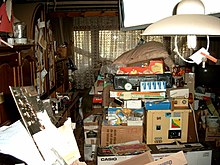| Hoarding disorder | |
|---|---|
| Other names | Compulsive hoarding |
 | |
| Compulsive hoarding in an apartment | |
| Specialty | Psychiatry, clinical psychology |
| Symptoms | Excessive acquisition, Perceived need to save possessions, Persistent difficulty discarding or parting with possessions, regardless of their actual value, Intense urge to keep items and distress when getting rid of them. |
| Usual onset | Ages 11–15[1] |
| Duration | Chronic[2] |
| Causes | Not clear, possibly genetic, and stressful life experiences[1] |
| Risk factors | Traumatic events[3] |
| Diagnostic method | ICD-10-CM Code F42.3, DSM-5 300.3 (F42) |
| Treatment | Psychotherapy[4] |
| Prognosis | Progressive[2] |
| Frequency | UK: 2–5% of population US: Up to 6%[5] GER: c. 1.8 million[6] |
Hoarding disorder (HD) or Plyushkin's disorder, is a mental disorder[7] characterised by persistent difficulty in parting with possessions and engaging in excessive acquisition of items that are not needed or for which no space is available. This results in severely cluttered living spaces, distress, and impairment in personal, family, social, educational, occupational, or other important areas of functioning.[7][8] Excessive acquisition is characterized by repetitive urges or behaviours related to amassing or buying property. Difficulty discarding possessions is characterized by a perceived need to save items and distress associated with discarding them. Accumulation of possessions results in living spaces becoming cluttered to the point that their use or safety is compromised.[9] It is recognised by the eleventh revision of the International Classification of Diseases (ICD-11)[10][11] and the Diagnostic and Statistical Manual of Mental Disorders, 5th edition (DSM-5).[12]
Prevalence rates are estimated at 2% to 5% in adults,[13] though the condition typically manifests in childhood with symptoms worsening in advanced age, at which point collected items have grown excessive and family members who would otherwise help to maintain and control the levels of clutter have either died or moved away.[14]
People with hoarding disorder commonly live with other complex and/or psychological disorders such as depression,[15] anxiety, obsessive compulsive disorder (OCD), autism spectrum disorder (ASD), and/or attention deficit hyperactivity disorder (ADHD).[16] Other factors often associated with hoarding include alcohol dependence and paranoid, schizotypal and avoidant traits.[17]
- ^ a b "Hoarding disorder – Symptoms and causes". Mayo Clinic. Retrieved 17 March 2019.
- ^ a b Grisham JR, Frost RO, Steketee G, Kim HJ, Hood S (2006). "Age of onset of compulsive hoarding". Journal of Anxiety Disorders. 20 (5): 675–686. doi:10.1016/j.janxdis.2005.07.004. PMID 16112837.
- ^ Cromer KR, Schmidt NB, Murphy DL (November 2007). "Do traumatic events influence the clinical expression of compulsive hoarding?". Behaviour Research and Therapy. 45 (11): 2581–2592. doi:10.1016/j.brat.2007.06.005. PMID 17673166.
- ^ "Hoarding disorder – Diagnosis and treatment – Mayo Clinic". www.mayoclinic.org.
- ^ Solovitch S (April 11, 2016). "Hoarding is a serious disorder – and it's only getting worse in the U.S." The Washington Post. Retrieved 17 March 2019.
- ^ "Messie-Syndrom: Löcher in der Seele stopfen". September 2002. Retrieved 27 May 2022.
- ^ a b Sun, Lena H. (2023-05-18). "Updates to psychiatry's guidebook change criteria for ADHD, autism". Washington Post. ISSN 0190-8286. Retrieved 2023-09-18.
- ^ "US mental health 'bible' DSM-5 updated". BBC News. 2013-05-17. Retrieved 2023-09-18.
- ^ "Clinical Classification of Hoarding Disorder | OCD-UK". Retrieved 2021-10-01.
- ^ Ng, Huiwen (2019-05-28). "'Doctor, I can't stop playing video games': 6 things about WHO's latest catalogue for diagnosing medical conditions worldwide". The Straits Times. ISSN 0585-3923. Retrieved 2023-09-19.
- ^ Fontenelle, Leonardo F.; Grant, Jon E. (2014). "Hoarding disorder: a new diagnostic category in ICD-11?". Revista Brasileira de Psiquiatria (Sao Paulo, Brazil: 1999). 36 (Suppl 1): 28–39. doi:10.1590/1516-4446-2013-1269. ISSN 1809-452X. PMID 25388610.
- ^ American Psychiatric Association (2022). Diagnostic and Statistical Manual of Mental Disorders. doi:10.1176/appi.books.9780890425787. ISBN 978-0-89042-575-6. S2CID 249488050. Retrieved 2023-09-09 – via DSM Library.
- ^ Pertusa A, Frost RO, Fullana MA, Samuels J, Steketee G, Tolin D, et al. (June 2010). "Refining the diagnostic boundaries of compulsive hoarding: a critical review". Clinical Psychology Review. 30 (4): 371–386. doi:10.1016/j.cpr.2010.01.007. PMID 20189280.
- ^ Ayers CR, Saxena S, Golshan S, Wetherell JL (February 2010). "Age at onset and clinical features of late life compulsive hoarding". International Journal of Geriatric Psychiatry. 25 (2): 142–149. doi:10.1002/gps.2310. PMC 4083761. PMID 19548272.
- ^ Kancherla N, Garlapati SK, Sowkhya P, Yegateela T, McCrary A (June 2022). "A Case of Coexisting Depression and Hoarding Disorder". Cureus. 14 (6): e25645. doi:10.7759/cureus.25645. PMC 9249064. PMID 35784984.
- ^ "Hoarding Definition – Diseases and Conditions". Mayo Clinic. 2011-05-25. Archived from the original on 2013-10-24. Retrieved 2014-05-01.
- ^ Samuels JF, Bienvenu OJ, Grados MA, Cullen B, Riddle MA, Liang KY, et al. (July 2008). "Prevalence and correlates of hoarding behavior in a community-based sample". Behaviour Research and Therapy. 46 (7): 836–844. doi:10.1016/j.brat.2008.04.004. PMC 2483957. PMID 18495084.